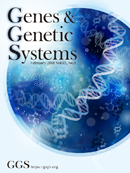Volume 99
Displaying 1-18 of 18 articles from this issue
- |<
- <
- 1
- >
- >|
GGS Prize
-
2024Volume 99 Article ID: prize_2024
Published: 2024
Released on J-STAGE: January 21, 2025
Download PDF (34K)
Subject Index
-
2024Volume 99 Article ID: subjectindex_99_2024
Published: 2024
Released on J-STAGE: January 08, 2025
Download PDF (51K)
Author Index
-
2024Volume 99 Article ID: authorindex_99_2024
Published: 2024
Released on J-STAGE: January 08, 2025
Download PDF (19K)
Short Communication
-
Article type: Short Communication
2024Volume 99 Article ID: 24-00093
Published: 2024
Released on J-STAGE: December 28, 2024
Advance online publication: November 02, 2024Download PDF (315K) Full view HTML
Methods, Technology, and Resources
-
Article type: Methods, Technology, and Resources
2024Volume 99 Article ID: 24-00112
Published: 2024
Released on J-STAGE: December 21, 2024
Advance online publication: October 28, 2024Download PDF (224K) Full view HTML
Corrigendum
-
Article type: Corrigendum
2024Volume 99 Article ID: corrigendum_22-00138
Published: 2024
Released on J-STAGE: November 06, 2024
Download PDF (22K)
Full paper
-
Article type: Full paper
2024Volume 99 Article ID: 24-00061
Published: 2024
Released on J-STAGE: October 18, 2024
Advance online publication: August 10, 2024Download PDF (939K) Full view HTML
Full paper
-
Article type: Full paper
2024Volume 99 Article ID: 24-00068
Published: 2024
Released on J-STAGE: September 18, 2024
Advance online publication: June 29, 2024Download PDF (3274K) Full view HTML
Short communication
-
Article type: Short communication
2024Volume 99 Article ID: 24-00017
Published: 2024
Released on J-STAGE: September 13, 2024
Advance online publication: July 19, 2024Download PDF (1188K) Full view HTML
Short communication
-
Article type: Short communication
2024Volume 99 Article ID: 24-00023
Published: 2024
Released on J-STAGE: July 25, 2024
Advance online publication: May 24, 2024Download PDF (330K) Full view HTML
Short communication
-
Article type: Short communication
2024Volume 99 Article ID: 23-00340
Published: 2024
Released on J-STAGE: May 24, 2024
Advance online publication: March 29, 2024Download PDF (309K) Full view HTML
Full paper
-
Article type: Full paper
2024Volume 99 Article ID: 23-00320
Published: 2024
Released on J-STAGE: May 10, 2024
Advance online publication: February 28, 2024Download PDF (1165K) Full view HTML
Methods, technology, and resource
-
Article type: Methods, technology, and resource
2024Volume 99 Article ID: 24-00020
Published: 2024
Released on J-STAGE: April 18, 2024
Advance online publication: March 07, 2024Download PDF (1890K) Full view HTML
Full paper
-
Article type: Full paper
2024Volume 99 Article ID: 23-00260
Published: 2024
Released on J-STAGE: March 29, 2024
Advance online publication: February 21, 2024Download PDF (1406K) Full view HTML
Review
-
Article type: Review
2024Volume 99 Article ID: 23-00287
Published: 2024
Released on J-STAGE: March 29, 2024
Advance online publication: February 21, 2024Download PDF (684K) Full view HTML
Full paper
-
Article type: Full paper
2024Volume 99 Article ID: 23-00239
Published: 2024
Released on J-STAGE: March 26, 2024
Advance online publication: February 21, 2024Download PDF (3382K) Full view HTML
Full paper
-
Article type: Full paper
2024Volume 99 Article ID: 23-00284
Published: 2024
Released on J-STAGE: March 26, 2024
Advance online publication: February 21, 2024Download PDF (933K) Full view HTML
Full paper
-
Article type: Full paper
2024Volume 99 Article ID: 23-00297
Published: 2024
Released on J-STAGE: March 26, 2024
Advance online publication: February 21, 2024Download PDF (2399K) Full view HTML
- |<
- <
- 1
- >
- >|
